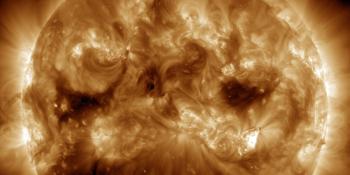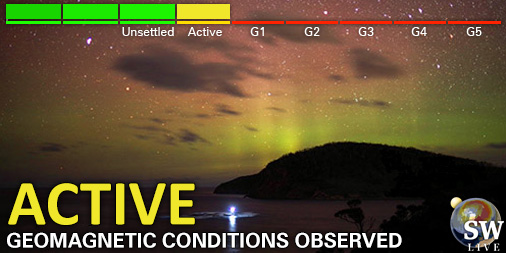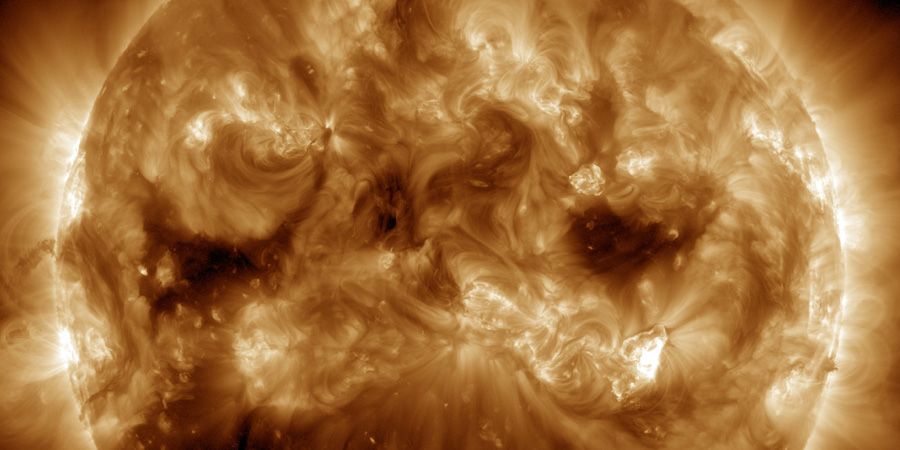Viewing archive of Monday, 22 April 2024
Geophysical report
Solar and Geophysical Activity Summary 2024 Apr 22 0245 UTCPrepared by the NOAA © SWPC and processed by SpaceWeatherLive.com
Joint USAF/NOAA Solar and Geophysical Activity Summary
SGAS Number 113 Issued at 0245Z on 22 Apr 2024 This report is compiled from data received at SWO on 21 AprA. Energetic Events
Begin Max End Rgn Loc Xray Op 245MHz 10cm Sweep 0100 0113 0124 3645 S09W23 C5.7 Sf 170 0335 0335 0335 320 0425 0434 0439 3638 S08W29 C3.9 Sf 330 1239 1259 1334 3645 S06W25 M1.0 1f 190 1507 1514 1520 3646 N22E19 M2.2 Sf 120 2144 2152 2157 3638 S17W37 M3.4 Sn 380 120 2210 2214 II
B. Proton Events
C. Geomagnetic Activity Summary
D. Stratwarm
E. Daily Indices: (real-time preliminary/estimated values)
10 cm 217 SSN 283 Afr/Ap 014/018 X-ray Background C2.1 Daily Proton Fluence (flux accumulation over 24 hrs) GT 1 MeV 2.9e+05 GT 10 MeV 1.5e+04 p/(cm2-ster-day) (GOES-18 satellite synchronous orbit W137 degrees) Daily Electron Fluence GT 2 MeV 8.50e+06 e/(cm2-ster-day) (GOES-16 satellite synchronous orbit W75 degrees) 3 Hour K-indices Boulder 2 4 3 4 3 3 2 2 Planetary 3 4 3 4 3 3 4 3
F. Comments
None.
All times in UTC
Current data suggests there is a slight possibility for aurora to appear at the following high latitude regions in the near future
Gillam, MB, Iqaluit, NU, Yellowknife, NTNuuk
Latest news
Latest forum messages
Support SpaceWeatherLive.com!
A lot of people come to SpaceWeatherLive to follow the Sun's activity or if there is aurora to be seen, but with more traffic comes higher server costs. Consider a donation if you enjoy SpaceWeatherLive so we can keep the website online!

Latest alerts
02:45 UTC - Geomagnetic activity
Active geomagnetic conditions (Kp4) Threshold Reached: 02:33 UTC
Saturday, 22 March 2025
23:45 UTC - Geomagnetic activity
Minor G1 geomagnetic storm (Kp5) Threshold Reached: 23:37 UTC
Strong G3 geomagnetic storm watch for 23 March
Yesterday around 16 UTC an M1.2 solar flare took place around sunspot region 4028. The solar flare triggered a filament eruption which erupted from the center of the earth-facing solar disk.
Read more12:18 UTC - Hemispheric Power Index
The OVATION model predicts the Hemispheric Power Index to reach 75GW at 13:10 UTC
Space weather facts
| Last X-flare | 2025/02/23 | X2.0 |
| Last M-flare | 2025/03/21 | M1.2 |
| Last geomagnetic storm | 2025/03/22 | Kp6- (G2) |
| Spotless days | |
|---|---|
| Last spotless day | 2022/06/08 |
| Monthly mean Sunspot Number | |
|---|---|
| February 2025 | 154.6 +17.6 |
| March 2025 | 142 -12.6 |
| Last 30 days | 139.8 -13.6 |





